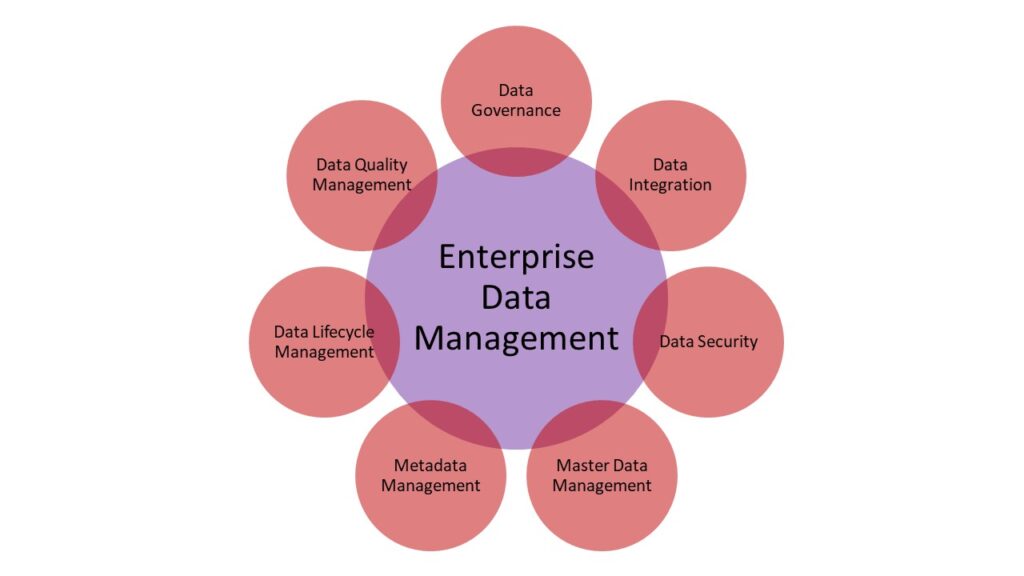Enterprise Data Management (EDM) – Everything You Should Know

Data reigns supreme as the ultimate driver for success in the fast-paced realm of modern regulated business. Business enterprises produce large amounts of data daily at a rapid pace. So, they must discover a way to securely arrange, manage, and seamlessly incorporate this data into their operations. Enterprise data management (EDM) helps to prevent data duplication, remove organizational silos, improve efficiency, reduce cost, support compliance efforts, and ultimately improve the overall operational performance. This blog post will guide you about enterprise data management and highlight everything you want to know about EDM.
Enterprise Data Management (EDM) Explained
Enterprise Data Management (EDM in software) refers to an organization’s capacity to define, integrate, access, and retain data for internal operations, applications, and external interactions. The primary objective of Enterprise Data Management is to establish and uphold reliability, confidence, and credibility in all data resources. An integral aspect of enterprise data management involves human participation, ensuring adherence to data governance principles and facilitating access to necessary information for individuals.
Components Of Enterprise Data Management
Effective enterprise data management (EDM) relies on fundamental components to maintain the integrity, accessibility, and security of an organization’s data. These significant components are crucial in establishing a strong EDM structure that facilitates data-informed decision-making and strategic business maneuvers. The main components of enterprise data management include:
- Data Integration
- Master Data Management
- Data Quality Management
- Data Governance
- Data Warehouses

Data Integration
A triumphant enterprise data management strategy needs effective data integration. It includes seamlessly formats into a single repository and integrates data from diverse sources so that it is valuable and accessible. Companies can incorporate data effortlessly, removing barriers between datasets, optimizing data utilization, and facilitating efficient decision-making processes driven by data. Multiple forms of data integration exist, like federation, virtualization, propagation, and consolidation.
Master Data Management
Master data management (MDM) is the management, organizing, centralizing, localizing, categorizing, synchronizing, and enhancing master data according to an organization’s business rules related to marketing, sales, and operational strategies. MDM processes guarantee that a company relies on a single, accurate, and valuable data version, often called a golden record. With MDM, employees can harmonize disparate data sources and ensure uniformity in downstream analytics and applications.
Data Quality Management
Data gathered from different sources may lack organization, reliability, or accuracy. Using such data poses risks of making flawed business decisions and impeding organizational progress. Data quality management ensures reliability, accuracy, and consistency across its lifecycle. Thus, by implementing data validation, cleaning, and other quality assurance measures, companies can improve data quality, boost operational efficiency, and gain a competitive advantage.
Data Governance
Data governance programs involve representatives from various departments within the organization and guarantee that appropriate data responsibilities are delegated to the relevant individuals. These initiatives entail establishing a framework for external and internal accountability while optimizing the data flow within the organization. Through effective data governance, a company can ensure the utmost protection of user privacy, adherence to regulations, and ethical conduct across all levels of responsibility.
Read Also: 7 Different Types of BI in Data Analytics
Data Warehouses
Data warehouses house extensive business data to help companies in decision-making processes. These storage facilities securely house current and historical data gathered from diverse sources. It is crucial to the data analytics framework, they facilitate analytics, decision support, data mining, and business intelligence. The concept of data warehouses has existed for over three decades, evolving to transition data from operational use to powering decision support and business intelligence systems.
Benefits of Enterprises Data Management
Enterprise data management (EDM) has the potential to assist businesses in thriving and evolving by enhancing data quality, streamlining workflows, enhancing decision-making processes, and safeguarding data integrity. These benefits encompass:
- Improved Decision-Making
- Strengthened Compliance
- Improved Operational Efficiency
Improved Decision-Making
Imagine marketing campaigns aimed at the incorrect customer groups because of inaccurate data. Nevertheless, with a centralized and accurate data pool, your teams are optimally positioned to derive insights that guide decision-making. Business decisions have a direct impact on profitability. Through a proficient enterprise data management system, your organization’s decision-makers can enhance innovation and concurrently reduce risks linked to data breaches and non-compliance.
Strengthened Compliance
Full control over your data significantly simplifies the implementation of data governance practices, access controls, and data retention policies. Properly executed, these practices enable your organization to adhere to data privacy regulations like CCPA or GDPR to reduce legal risks. Moreover, a properly organized data infrastructure streamlines both internal and external audits by simplifying the intricate processes involved in data collection and verification during compliance checks.
Improved Operational Efficiency
Data silos within the enterprise result in isolated departments operating with incomplete or potentially inconsistent information. Overcoming these silos and attaining a Single Source of Truth (SSOT) necessitates a centralized repository serving as the sole entry and access point for all departments. Strategically managing enterprise data eradicates these silos and discrepancies, facilitating smooth data exchange and collaboration among departments. This leads to more efficient workflows, quicker task completions, and lowered expenses.
Read Also: Is it Possible to Recover Data from a Dead or Damaged Hard Drive?
Enterprise Data Management Challenges
When executed correctly, a strategy for managing enterprise data can empower your organization to utilize reliable data for its data-driven projects. However, its implementation presents several challenges, with the most significant being:
- Modernizing Legacy Systems
- Retaining Skilled Data Professionals
- Integrating Company-Wide Data
- Complying with Regulations
Modernizing Legacy Systems
Enterprise Data Management (EDM) necessitates a comprehensive grasp of the origins and modifications of data. However, legacy systems’ outdated formats or proprietary databases often need adequate documentation regarding data flow, origins, and transformations. The absence of data lineage poses challenges in comprehending data significance and verifying its reliability. Consequently, migrating such data to a contemporary system demands meticulous planning and execution to preserve its accuracy.
Retaining Skilled Data Professionals
Effectively overseeing enterprise data necessitates competent professionals who possess expertise in data architecture, adhere to best practices, and are proficient with the organization’s tools. Likewise, crafting and implementing a fruitful data strategy requires seasoned personnel. Nonetheless, the need for proficient data professionals surpasses the current pool of available talent, presenting organizations with difficulties attracting and retaining top-tier individuals.
Integrating Company-Wide Data
Imagine overseeing enterprise data from numerous departments, each utilizing its systems and formats. Customer data might be dispersed among marketing databases, sales CRM platforms, and loyalty programs. Financial information could be housed in distinct accounting and ERP systems. The difficulty lies in consolidating data from various origins and in doing so without jeopardizing its integrity.
Complying with Regulations
A significant hurdle is navigating the regulatory terrain, particularly in tightly regulated sectors. Establishing and upholding procedures and platforms that adhere to these varied and evolving standards can drain resources. Moreover, conflicting or overlapping mandates across different regulations can complicate the development of a holistic compliance approach.
Final Verdict
Enterprise Data Management (EDM) empowers companies by improving data quality, simplifying workflows, enhancing decision-making, reducing expenses, fostering innovation, safeguarding data, and enhancing the customer experience. Organizations can unlock numerous benefits by integrating data from diverse sources, ensuring its quality and security, and establishing robust governance frameworks. However, navigating the challenges of legacy systems, talent retention, data integration, and regulatory compliance requires strategic planning and execution. Ultimately, embracing EDM enables businesses to stay competitive in the data-driven landscape, driving innovation and sustainable growth.






